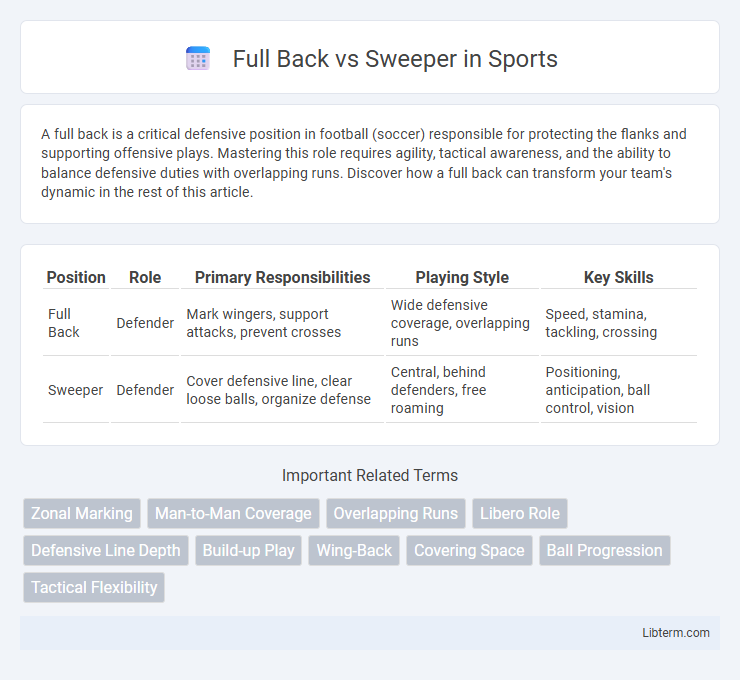A full back is a critical defensive position in football (soccer) responsible for protecting the flanks and supporting offensive plays. Mastering this role requires agility, tactical awareness, and the ability to balance defensive duties with overlapping runs. Discover how a full back can transform your team's dynamic in the rest of this article.
Table of Comparison
| Position | Role | Primary Responsibilities | Playing Style | Key Skills |
|---|---|---|---|---|
| Full Back | Defender | Mark wingers, support attacks, prevent crosses | Wide defensive coverage, overlapping runs | Speed, stamina, tackling, crossing |
| Sweeper | Defender | Cover defensive line, clear loose balls, organize defense | Central, behind defenders, free roaming | Positioning, anticipation, ball control, vision |
Introduction to Defensive Roles in Football
The full back primarily defends against opposing wingers by marking and intercepting crosses along the flanks, ensuring wide defensive coverage. The sweeper operates centrally behind the defensive line, responsible for clearing loose balls and providing an additional layer of security against through passes. Both roles are vital in maintaining defensive solidity, with the full back focusing on wide areas and the sweeper on central defensive organization.
What is a Full Back?
A Full Back is a defensive football position primarily tasked with defending against opposing wingers and supporting offensive plays by providing width and crossing opportunities. Positioned on the flanks of the defensive line, Full Backs combine speed, stamina, and tactical awareness to block attacks and initiate forward momentum. Unlike Sweepers who operate centrally with a freer role to cover defensive gaps, Full Backs consistently mark wide attackers and contribute to team formations in both defense and attack.
What is a Sweeper?
A sweeper, also known as a libero, is a defensive player positioned behind the main line of defenders, responsible for "sweeping up" loose balls and providing an extra layer of defense. Unlike a full back who primarily marks opposing wingers and supports wide defensive coverage, a sweeper operates centrally with greater freedom to intercept passes and initiate counterattacks. Key attributes of a sweeper include exceptional reading of the game, strong tackling skills, and the ability to distribute the ball effectively to transition from defense to offense.
Historical Evolution of Full Backs and Sweepers
Full backs historically originated as defensive players positioned on the flanks, tasked with marking wingers and preventing crosses, evolving into dynamic roles supporting both defense and attack through overlapping runs. Sweepers emerged later as a tactical innovation in the mid-20th century, pioneered by players like Franz Beckenbauer, operating behind the defensive line with the freedom to intercept threats and initiate counterattacks. The evolution reflects a shift from rigid marking systems to more fluid defensive strategies emphasizing versatility, spatial awareness, and playmaking abilities.
Key Responsibilities: Full Back vs Sweeper
Full Backs primarily focus on defending wide areas, marking opposing wingers, and supporting offensive overlaps along the flanks. Sweepers act as the last line of defense, positioned centrally behind the main defensive line, tasked with intercepting through balls and organizing the backline. While Full Backs balance defensive and attacking duties on the wings, Sweepers specialize in providing coverage and initiating build-up play from deeper positions.
Tactical Importance in Modern Football
Full backs provide essential width and support in both defense and attack by overlapping wingers and maintaining team shape, often contributing to pressing and quick counterattacks. Sweepers, once pivotal in covering defensive gaps and organizing the backline, have largely been replaced by ball-playing center-backs in modern tactics due to the evolution of high defensive lines and zonal marking. The tactical importance of full backs has surged with their dual role in offensive buildup and defensive transitions, making them crucial for maintaining balance and fluidity in contemporary football formations.
Physical and Technical Attributes Required
A Full Back requires exceptional speed, stamina, and agility to both defend against wingers and support offensive plays through overlapping runs, along with strong tackling and crossing abilities. A Sweeper demands superior positional awareness, composure under pressure, and proficient ball control to intercept through balls and initiate counterattacks, emphasizing anticipation and precise short passing. Both roles necessitate physical resilience, but Full Backs emphasize endurance and pace, whereas Sweepers rely more on spatial intelligence and technical finesse.
Famous Full Backs and Sweepers in History
Famous full backs like Cafu and Roberto Carlos revolutionized the role with their attacking prowess and defensive solidity, often contributing goals and assists from the flanks. Sweepers such as Franz Beckenbauer and Gaetano Scirea redefined defensive strategy by playing a libero role, controlling the game from behind the main defense with exceptional vision and ball-playing skills. The contrast between full backs' wide positioning and sweepers' central free-roaming became a fundamental tactical distinction in football history.
Pros and Cons: Full Back vs Sweeper
Full backs provide width and defensive solidity by marking wingers and supporting attacks down the flanks, offering pace and stamina but sometimes lacking central defensive coverage. Sweepers excel in reading the game and clearing threats behind the defensive line, offering high tactical awareness and flexibility but can be vulnerable to quick transitions due to their deeper positioning. Teams often choose full backs for dynamic wing play and sweepers for strong central defense organization, balancing offensive support against deep defensive resilience.
Conclusion: Choosing the Right Role for Your Team
Selecting between a full back and a sweeper depends on your team's tactical approach and defensive priorities. Full backs excel in providing wide defensive coverage and supporting offensive plays with overlapping runs, crucial for teams emphasizing flank attacks. Sweepers offer a last line of defense with strategic positioning and interception skills, ideal for teams focusing on organized, compact defensive structures.
Full Back Infographic

 libterm.com
libterm.com